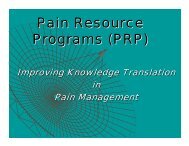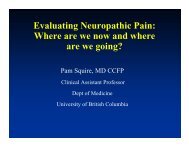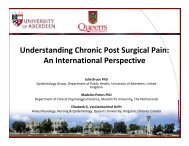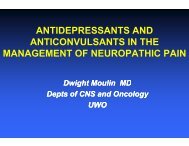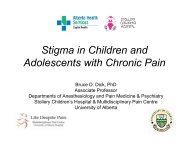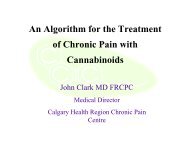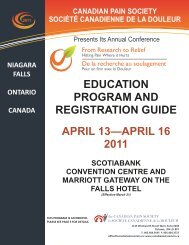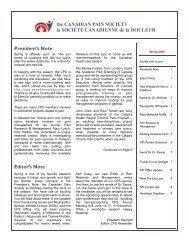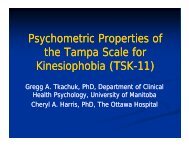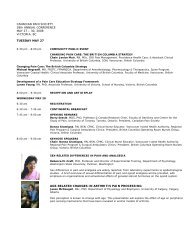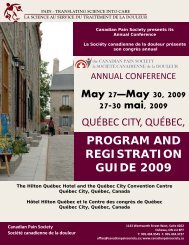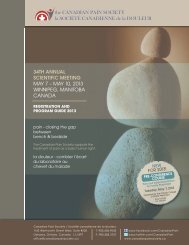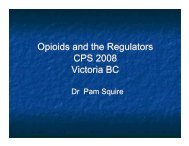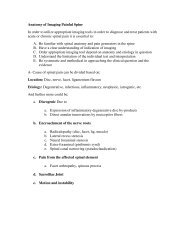Session 208 - LeFort - The Canadian Pain Society
Session 208 - LeFort - The Canadian Pain Society
Session 208 - LeFort - The Canadian Pain Society
Create successful ePaper yourself
Turn your PDF publications into a flip-book with our unique Google optimized e-Paper software.
Chronic <strong>Pain</strong> Self-Management:<br />
Results of Two Randomized<br />
Controlled Trials<br />
Sandra M. <strong>LeFort</strong>, PhD, RN<br />
School of Nursing, Memorial University of<br />
Newfoundland<br />
Judith Watt-Watson RN PhD, Karen Webber RN MN<br />
Denise Guerriere RN PhD, Peter Coyte PhD,<br />
Ruth Croxford MSc
<strong>The</strong> current situation<br />
An estimated 14% - 39% of the adult<br />
population suffer from chronic non-cancer pain<br />
- can result in deep distress & disability and<br />
cause major disruption in individual and family<br />
functioning<br />
- third leading cause for absence from work in<br />
the United States<br />
- economic impact is high (estimated > $ 61B<br />
U.S.$)
<strong>The</strong> problem of access<br />
In spite of high prevalence and impact on<br />
individuals, families and society, access to<br />
specialty pain services is limited by:<br />
‣ nature of the referral process<br />
- we wait too long to refer -- most disabled referred<br />
‣ geographic location<br />
- urban tertiary care centres<br />
‣ cost and resource constraints<br />
- cost containment issues in health care generally
<strong>The</strong> need for community-based<br />
programs<br />
Need for a low-cost, accessible, community-based<br />
intervention to assist individuals to better manage<br />
their chronic pain to improve QOL.<br />
‣“an intervention that can be widely disseminated<br />
even if it is only moderately effective, may have<br />
greater impact on patient care than a more effective<br />
treatment approach that is more restricted in terms<br />
of numbers of patients that can be treated” (Turk,<br />
et al., 1993)
CPSMP: Description<br />
a standardized, community-based program adapted<br />
from the Stanford Arthritis Self-Management Program<br />
designed to enhance ability to manage everyday<br />
experience of chronic pain by learning about: problemsolving,<br />
multiple strategies for symptom management,<br />
safe exercise, managing emotions, communication<br />
runs for 2 hrs/week for 6 weeks with 7-10 individuals<br />
with a facilitator
From ASMP to CPSMP<br />
- Process elements were not changed.<br />
- Changes in content areas included:<br />
‣information about chronic pain<br />
‣pacing (balancing activity & rest)<br />
‣exercise (ROM Exercise)<br />
‣nutrition<br />
‣breathing and body awareness<br />
‣communication skills (how to talk about pain)<br />
‣medications
CPSMP:<br />
Program<br />
Content<br />
and<br />
Format
Process Components<br />
Mini-lectures<br />
‣ information sharing<br />
Self-reflection — sharing of feelings<br />
‣ what chronic pain means to me, communication<br />
issues<br />
Quiz<br />
‣ myths about chronic pain<br />
Brainstorming<br />
‣about benefits of exercise, symptoms of depression
Process (cont.)<br />
Setting weekly contracts/action plans<br />
‣ learning the process of setting short term goals<br />
Feedback<br />
‣ about how well they are doing (verbal & written)<br />
Group problem-solving<br />
‣ depression, solving problems that arise with the<br />
contract<br />
Telephone support mid-week
Efficacy Enhancing Strategies<br />
- Feedback: action planning & reporting back;<br />
exercise diary<br />
- Modeling: participants serve as models for each<br />
other<br />
- Reinterpreting symptoms and changing beliefs -<br />
cognitive reframing<br />
-Persuasion- by seeing others succeed in class,<br />
by encouragement to do a ‘bit’ more
Participant materials<br />
Package of information which includes:<br />
‣150 page workbook<br />
‣ relaxation tape<br />
‣current pamphlets on nutrition and walking<br />
‣ an exercise diary<br />
‣ a relaxation audio tape
CPSMP RCT #1: Efficacy Trial<br />
Study funded by NHRDP<br />
<strong>LeFort</strong>, S. et al. A randomized controlled trial of a<br />
community-based psychoeducation program for the<br />
self-management of chronic pain. <strong>Pain</strong>. 1998; 74; 297-<br />
306.<br />
<strong>LeFort</strong>, S. (2000). A test of Braden’s Self-Help Model in<br />
Adults with chronic pain. Journal of Nursing<br />
Scholarship, 32(2), 153-160.
CPSMP RCT #1 – Efficacy Trial
Results: Subject Characteristics<br />
Mean age (range) 39.5 yrs (24-60)<br />
Gender (% female) 73%<br />
Education<br />
‣ (% high school graduate) 89%<br />
Employment (% working) 38%<br />
Mean pain duration 6.5 yrs (1-28)<br />
# pain locations 6 sites (1-20)<br />
Back/neck pain (%) 68%<br />
Medications for pain 81%<br />
Physician/specialist visit 62% in past 30 days
Results:<br />
statistically reliable improvement in health status<br />
measures (pain, independence, social/role functioning,<br />
physical functioning, vitality, self-efficacy/resourcefulness)<br />
improvement in treatment group ranged from 9% to<br />
47% with most in the modest range<br />
comparable results compared to studies of ASMP and<br />
other pain programs reported in the literature<br />
results supported self-efficacy theory (i.e., confidence<br />
building and increased problem solving lead to better<br />
outcomes)
So, do community-based<br />
interventions help?<br />
<strong>The</strong> results of this efficacy trial were promising,<br />
but questions remained unanswered:<br />
1. Can the intervention be effectively delivered by<br />
generalist health care providers in the<br />
community?<br />
2. Are improvements maintained over the long<br />
term?<br />
3. Does it make a difference in terms of health<br />
care costs?
CIHR-funded CPSMP RCT #2:<br />
Effectiveness Trial (n=279)<br />
Larger study in varied rural and urban sites:<br />
‣3 in Newfoundland (St. John’s, Gander, Corner Brook)<br />
‣2 in Toronto and 1 in Halton<br />
‣1 in Regina<br />
Facilitators were community-based nurses and allied<br />
health care providers<br />
Baseline, 3 and 12 month data collection on major<br />
study variables and monthly <strong>Pain</strong> Care Diaries to track<br />
economic costs
Participant characteristics<br />
Mean age: 48 yrs<br />
% Female: 80%<br />
Working: 31%<br />
Mean pain duration: 9 yrs<br />
% back or neck pain: 75%<br />
Recent visit to health provider: 90%
Results (n=207)<br />
Statistically significant change:<br />
‣Mental Health Composite Score of the SF-36<br />
(includes vitality, social & emotional functioning,<br />
and mental health) (p = .001) and<br />
‣Resourcefulness (p = .006)<br />
Positive trends to improvement: disability,<br />
psychosocial adjustment to illness, & life<br />
satisfaction.<br />
Results maintained at 12 months
What chronic pain means to me…<br />
<strong>Session</strong> 1<br />
‣Isolation<br />
‣Constancy<br />
‣Limitation<br />
‣Loss<br />
‣Adversary<br />
<strong>Session</strong> 6<br />
‣ Learning from<br />
others/helping others<br />
‣ Validation<br />
‣ Coming to terms<br />
‣ Self-esteem<br />
‣ Knowledge & Selfknowledge<br />
‣ Hope/direction<br />
‣ Learning to manage
Estimated Yearly Overall<br />
Costs of Chronic <strong>Pain</strong><br />
Newfoundland Median Costs: $ 9,990<br />
Ontario Median Costs: $ 12,700<br />
Saskatchewan Median Costs: $ 5,620<br />
Costs in all 3 provinces were highest for younger<br />
participants, those who were not working, who had<br />
more education, and who lived with another adult.<br />
<strong>The</strong>re was a decrease in indirect health care costs for<br />
men who participated in the CPSMP.
Conclusions<br />
- Results suggest that community-based health care<br />
providers such as RNs can reliably deliver the CPSMP.<br />
- Participation in the CPSMP results in modest positive<br />
outcomes at 3 months that are maintained for up to a<br />
year<br />
- <strong>The</strong> CPSMP appears to reduce the indirect costs of<br />
chronic pain for men.<br />
- Results continue to support self-management education<br />
approaches.
Next steps…..<br />
- I did these studies as one clinician-researcher trying to<br />
implement a community-based approach as an adjunct<br />
to traditional care for chronic pain<br />
- Need to have buy-in from the local health authority to<br />
incorporate self-management into main stream care<br />
- <strong>The</strong>re are great examples of this happening (e.g., the<br />
State of Vermont; Calgary Health Authority with the<br />
CDSMP, the CPM Centres in Ontario; provinces of<br />
British Columbia and Nova Scotia)
- Also interest by the Public Health Agency of<br />
Canada and CIHR Institute of Musculoskeletal<br />
Health and Arthritis (IMHA) trying to impact<br />
policy and knowledge transfer<br />
- Newly funded CAHR grant in <strong>Pain</strong> and<br />
Knowledge Translation (PI: J. Henry)<br />
- <strong>The</strong>me 1: “From the Ground Up” – exploring<br />
patient and health system needs including selfmanagement<br />
programs
THANK YOU!



